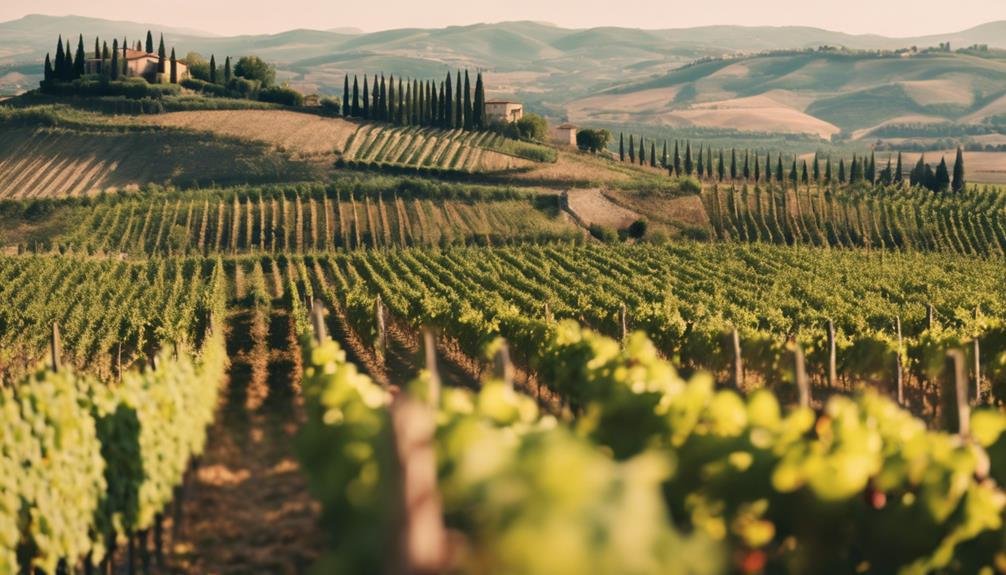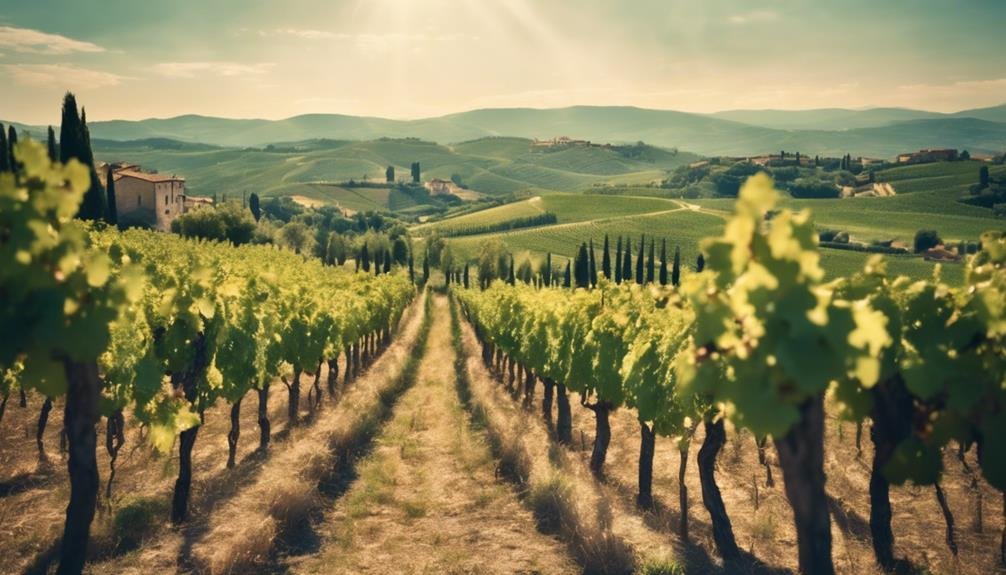Set out on a journey to Umbria to uncover its 13 wine regions, including Orvieto, Torgiano, and Montefalco, each renowned for unique grape varieties. Taste the Torgiano Rosso Riserva's blend or indulge in Montefalco Sagrantino's 100% Sagrantino grape profile. Explore vineyard insights on cultivation techniques, terroir, and blending methods that shape the richness and complexity of Umbrian wines. From the soil to the oak barrels, every step enhances flavors. Discover the diverse wines of Umbria, where each bottle tells a story of tradition and innovation, waiting to be savored.
Umbrias Diverse Wine Regions
Umbria boasts a rich tapestry of diverse wine regions, as depicted by the map showcasing 13 distinct wine-producing areas within the region. Exploring vineyards in Umbria offers a unique opportunity to investigate the regional varieties that make this Italian region so special.
From the renowned Orvieto to the prestigious Torgiano and Montefalco, each area contributes its own signature grapes to the region's winemaking heritage. The vineyards in Umbria not only showcase the beauty of the landscape but also highlight the variety of grapes cultivated in this fertile land.
Notable Wines of Umbria
Among the distinguished wines of Umbria, standout examples include the Torgiano Rosso Riserva DOCG, Montefalco Sagrantino DOCG, and Montefalco Rosso DOC. These wines showcase the unique characteristics of Umbrian terroir and winemaking expertise. When delving into Umbrian wines, it's crucial to savor the richness and complexity that each bottle offers.
Here are some notable wines from Umbria:
- Torgiano Rosso Riserva: A blend of Sangiovese, Canaiolo, and Trebbiano grapes, known for its elegance and structure.
- Montefalco Sagrantino: Made from 100% Sagrantino grape, producing bold and robust red wines.
- Montefalco Rosso: A blend of Sangiovese, Sagrantino, and other local varieties, offering a harmonious flavor profile.
- Orvieto DOC: Known for its white wine blends of Grechetto and Trebbiano grapes, showcasing freshness and minerality.
Vineyard Insights and Grape Varieties

Amidst the rich tapestry of Umbrian winemaking excellence, insights into vineyard cultivation practices and the array of grape varieties utilized offer a deeper understanding of the region's viticultural landscape.
Exploring varietal characteristics reveals the unique flavors and aromas each grape contributes to the final blend. Vineyard terroir, including soil composition and microclimate, plays an essential role in shaping grape development.
Grape blending techniques are carefully orchestrated to achieve a harmonious balance of flavors, showcasing the best qualities of each grape variety. Additionally, wine aging processes, whether in stainless steel tanks or oak barrels, impart distinct characteristics to the final product, enhancing its complexity and depth.
Understanding these aspects provides a glimpse into the artistry and precision behind Umbrian winemaking.
Frequently Asked Questions
What Are the Traditional Food Pairings for Umbrian Wines?
Traditional food pairings for Umbrian wines often include rich dishes such as roasted meats, truffles, and aged cheeses. Food festivals in Umbria celebrate local cuisine, featuring delicacies like wild boar, lentils, and olive oil that complement these wines perfectly.
Are There Any Unique Winemaking Techniques Used in Umbria?
Barrel aging brings boldness, natural fermentation nurtures nuances in Umbrian wines. Sustainable practices and biodynamic farming elevate winemaking in this region. These unique techniques uphold quality, enhancing the terroir's essence in every bottle.
How Do Umbrian Wines Compare to Other Italian Regions?
Umbrian wines stand out for their unique taste profiles, reflecting regional differences in grape varieties and winemaking techniques. Influenced by historical traditions and cultural significance, these wines offer a distinct character that sets them apart from other Italian regions.
What Is the Significance of the Grape Varieties in Umbrian Wines?
Exploring terroir in Umbrian wines reveals a tapestry of grape varieties. Cultivating diversity, Sangiovese, Sagrantino, Grechetto, and others weave intricate flavors, reflecting the region's rich heritage. Understanding these grapes uncovers the essence of Umbria's wine culture.
Are There Any Up-And-Coming Wineries to Watch in Umbria?
Emerging vineyards in Umbria are gaining recognition for their innovative blends. These wineries showcase unique grape varieties and winemaking techniques, setting them apart in the region. Keep an eye on these up-and-coming producers for exciting new additions to Umbrian wines.
Conclusion
In the world of Umbrian wines, tradition and innovation harmonize to create a tapestry of flavors that captivate the senses.
From the ancient vineyards of Orvieto to the prestigious designations of Torgiano and Montefalco, Umbria's diverse wine regions offer a rich heritage waiting to be explored.
Discover the unique varietals, vineyard insights, and the art of winemaking that define Umbria's winemaking traditions, and set out on a journey of discovery unlike any other.
